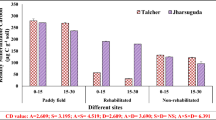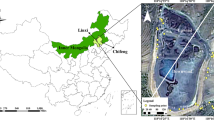Abstract
Coal mining activities have been ongoing in Okaba for years without adequate attention paid to pollution and reclamation. Soil and plants were sampled from Okaba coal mine to determine the metal content in the soil and to identify the plants that have potential for phytoremediation. The samples were prepared, separated into various tissues, and labeled and taken to the laboratory. Digestion was carried out using acid mixture of nitric acid (HNO3): perchloric acid (HCLO4) for the plants, while the mixture of nitric acid (HNO3): hydrochloric acid (HCl): perchloric acid (HCLO4) was used for the soil. The concentrations of metals from the samples were determined using EDX3600B X-ray fluorescence spectrometer (Sky ray Instruments Inc., USA), a World Bank Assisted Project, Nigeria. Bioconcentration factor (BCF), translocation factor (TF), and bioaccumulation coefficient (BAC) or extraction coefficient (EC) were determined to identify the plants that have potential for hyperaccumulation, phytoextraction, and phytostabilization and ability to store up these metals for harvesting. Hierarchical cluster analysis was performed to highlight the relationship between the variables. This study has revealed that Ageratum conyzoides Linn (ACL), Desmodium velutinum (DV), Triumfetta rhiomdoidea Jacq. (TRJ), Gleichenia linearis (Burns) (GL), Selaginella myosurus (SM), and Sida linifolia juss.excav. (SL) had potential as hyperaccumulators of nickel. Eleven (11) plants have potential for phytoextraction of manganese (Mn), and six (6) plants have stabilization potential for the same metal. Eight (8) phytoextractors and seven (7) stabilizers plants were recorded for Ni. Eclipta alba (L) Hassk (EAH) (location 4) and TRJ were phytostabilizers plants for Pb. Six (6) other plants have potential as phytoextractors of Pb. Eight (8) of the studied plants were suitable for phytoextraction of Ni, and five (5) plants were suitable as phytostabilizers. Most of the plants were found to be useful for phytoremediation of the soil.





Similar content being viewed by others
Data availability
All data generated or analyzed during this study were included in this article.
References
Ameh, E.G., & Aina, D.O. (2020). Search for autochthonous plants as accumulators and translocators in a toxic metal- Polluted coal mine soil in Okaba, Nigeria. Scientific African, Elsevier. https://doi.org/10.1016/j.sciaf.2020.e00630
Baker, A. J. M., & Brooks, R. R. (1989). Terrestrial higher plants which hyperaccumulate metallic elements- A review of their distribution, ecology, and phytochemistry. Biorecovery, 1, 81–126.
Balabanova, B., Stafilov, T., & Baceva, K. (2015). Bioavailability and bioaccumulation characterization of essential and heavy metal, contents in R. acetosa, S. oleracea, and U. dioica from copper polluted and referent areas. Journal of Environmental Health Science and Engineering, 13(2), 1–13.
Bowen, H. J. M. (1979). Environmental chemistry of the elements (p. 333). Academic Press.
Bu-Olayan, A. H., & Thomas, V. B. (2009). Translocation and bioaccumulation of trace metals in desert plants of Kuwait Governorates. Science Alert, 3, 581–587.
Cudic, V., Stojiljkovic, D., & Jovovic, A. (2016). Phytoremediation potential of wild plants growing on soil contaminated with heavy metals. Arhiv Za Higijenu Rada i Toksikologiju, 67, 229–239.
Farrag, H. F., Al-Sodany, Y. M., & Otiby, F. G. (2013). Phytoremediation and accumulation characteristics of heavy metal by some plants in Wadi Alargy-Wetland. Taif-KSA. World Applied Sciences Journal, 28(5), 644–653.
Hansford, T.S., & Boerngen, J.G. (1984). The average content of elements in the soil. US Geological Survey Paper 1270.
Harikumar, P. S., & Jisha, T. S. (2010). Distribution pattern of trace metal pollutants in the sediments of an urban wetland in the southwest coast of India. International Journal of Engineering Science and Technology, 2(5), 840–850.
Hosman, M.E., El-Feky, S.S., Elshahawy, M.I., & Shaker, E.M. (2017). Mechanism of phytoremediation potential of flax (linum usitatissimum L.) to Pb, Cd, and Zn. Asian Journal of plant science and research, 7(4), 30–40.
Iya, N. I. D., Assim, Z. B., Ipor, I. B., Omolayo, A. O., Umaru, I. J., & Jume, B. H. (2018). Accumulation and translocation of heavy metals by Acalypha wilkesiana parts in the phytoextraction of contaminated soil. Indonesia. J. Chem, 18(3), 503–513.
Kabata-Pendias, A., & Pendias, H. (1992). Trace elements in soils and plants. CRC Inc.
Kabata-Pendias, A., & Pendias, H. (2001). Trace elements in soils and plants (3rd ed.). CRC Press.
Lago-Vila, M., Arenas-Lago, D., Rodriquez-Seijo, A., Andrade Counce, M., & Vega, F. A. (2015). Cobalt, chromium, and nickel contents in soils and plants from a serpentinite quarry. Solid Earth, 6, 323–335.
Laluraj, C. M., Gopinath, G., & Dineshkumar, P. K. (2005). Groundwater chemistry of shallow aquifers in the coastal zones of Cochin. India. Applied Ecology and Environmental Research, 3(1), 133–139.
Lokhande, P. B., Patit, V. V., & Mujawar, H. A. (2008). Multivariate statistical analysis of groundwater in the vicinity of Mahad industrial area of Konkan region, India. International Journal of Applied Environmental Sciences, 23(2), 24–38.
Lorestani, B., Cheraghi, M., & Yousefi, N. (2011). Phytoremediation potential of native plants growing on heavy metals contaminated soil of copper mine in Iran. International Journal of Geological and Environmental Engineering, 5(5), 299–304.
Mehes, S. M., Nkogolo, K. K., Narendrula, R., & Cholewa, E. (2013). Mobility of heavy metals in plants and soil: A case study from a mining region in Canada. American Journal of Environmental Sciences, 9(6), 483–493.
Mellem, J. J., Baijnath, H., & Odhav, B. (2012). Bioaccumulation of Cr, Hg, As, Pb, Cu, and Ni with the ability for hyperaccumulation by Amaranthus dubius. African Journal of Agricultural Research, 7(4), 591–596.
Mkumbo, S., Mwegoha, W., & Renman, G. (2012). Assessment of the phytoremediation potential for Pb, Zn, and Cu of indigenous plants growing in a gold mining area in Tanzania. International Journal of Environmental Sciences, 2(4), 2425–2434.
Navarro, M. C., Pere-Sirvent, C., & Martinez-Sanchez., Vidal, J., Tovar, P.J., & Bech, J. (2008). Abandoned mine sites as a source of contamination by heavy metals: A case study in a semi-arid zone. Journal of Geochemical Exploration, 96, 183–193.
Nazir, A., Malik, R. N., Ajaib, M., Khan, N., & Siddiqui, M. F. (2011). Hyperaccumulators of heavy metals of industrial areas of Islamabad and Rawalpindi. Pakistan Journal of Botany, 43(4), 1923–1933.
Netty, S., Wardiyati, T., Maghfoer, M. D., & Handayanto, E. (2013). Bioaccumulation of Nickel by fine wild plant species on nickel contaminated soil. IOSR Journal of Engineering, 3(5), 01–06.
Nirola, R., Megharaj, M., Palanisami, T., Aryal, R., Venkateswarlu, K., & Naidu, R. (2015). Evaluation of metal uptake factors of native trees colonizing an abandoned copper mine - A quest for phytostabilization. Journal of Sustainable Mining, 14, 115–123.
Praveena, S. M., Ahmed, A., Radojevic, M., Abdullah, M. H., & Aris, A. Z. (2007). Factor-cluster analysis and enrichment study of mangrove sediments- An example from Mengkabong, Sabah. The Malaysian Journal of Analytical Sciences., 11(2), 421–430.
Rudnick, R., & Gao, S. (2003). Composition of the continental crust. In: Holland, HD; Turekian, KK (eds-in-chief) Treatise on geochemistry 3: Rudnick, RL. (eds), The crust, 1–64. Elsevier-Pergamon, Oxford.
Sagiroglu, A. A., & Sen, S. O. (2006). Hyperaccumlator plants of the Keban mining district and their possible impact on the environment. Polish Journal of Environmental Studies, 15(2), 317–325.
Shacklette, H.T., Josphine, G., & Boerngen, J.G. (1984). The average content of elements in the soil. US Geological Survey Paper 1270.
Singh, N., Kaur, M., & Katnoria, J. K. (2017). Analysis of bioaccumulation of metals in the aquatic environment of Beas River Basin: A case study from Kanli wetland. GeoHealth, 1, 93–105.
Yanhong, L., Hongji, L., Tao, H., Huiying, L., & Jinmin, F. (2013). Toxic effects, uptake, and translocation of Cd and Pb in perennial ryegrass. Ecotoxicology, 22, 207–214.
Yoon, J., Xinde, C., Qixing, Z., & Len, Q. M. (2006). Accumulation of Pb, Cu, and Zn in native plants growing on a contaminated Florida site. Science of the Total Environment, 368, 456–464.
Acknowledgements
We are grateful to both field and laboratory teams for their expertise and all the resource persons that corrected the grammatical errors are highly appreciated. People who took part in the research were all acknowledged.
Author information
Authors and Affiliations
Contributions
EA carried out the design, sample identification and collection, analysis, interpretation, and writing. DA carried out the sample identification and collection, sample preparation, and analysis. SA carried out sample identification, sample preparation and analysis, and writing and grammatical corrections. All the authors have read and approved the final manuscript for publication.
Corresponding author
Ethics declarations
Competing interests
The authors declare no competing interests.
Additional information
Publisher's Note
Springer Nature remains neutral with regard to jurisdictional claims in published maps and institutional affiliations.
Rights and permissions
About this article
Cite this article
Ameh, E.G., Awulu, D.T. & Akinde, S.B. Phytoremediation tool for restoration of metal-polluted coal mine soil in Okaba, Nigeria: a hierarchical cluster approach. Environ Monit Assess 193, 514 (2021). https://doi.org/10.1007/s10661-021-09308-3
Received:
Accepted:
Published:
DOI: https://doi.org/10.1007/s10661-021-09308-3




